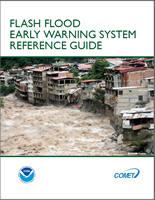Flash Flood Early Warning Systems
Flash Flood Early Warning System Reference Guide (Spanish version)
According to the World Meteorological Organization, flash floods are the most lethal form of natural hazard (based upon the ratio of fatalities to people affected), and cause millions of dollars in property damage every year. Yet despite their significance, only a few countries have implemented flash flood forecasting systems, in part due to technical complexity in predicting flash flood events. Recent technological advancements are making such systems increasingly affordable and effective. Now, flash-flood prone countries have a range of options to create local, regional and global systems capable of protecting vulnerable populations from flash floods.
The U.S. National Weather Service and The COMET Program has developed the Flash Flood Early Warning Systems Reference Guide, which provides an authoritative set of guidelines for the design and operation of successful flash flood early warning systems. The Guide is intended to promote the implementation of flash flood early warning systems, based upon proven and effective methods already in use in flash-flood prone nations around the world. It will serve as a reference to both governmental and non-governmental decision makers uncertain of the process and components that constitute a robust, end-to-end flash flood early warning system.
In addition to providing guidance for developing a Concept of Operations of a flash flood early warning system, the guide includes more detailed chapters on Flash Flood Science, Flash Flood Forecasting Methods, Monitoring Networks, Technology Infrastructure, Warning Dissemination and Notification, and Community-based Disaster Management, and several examples of Flash Flood Early Warning Systems.
Full Guide (PDF, 23MB)
Individual Chapters (PDF)
Chapter 1: Introduction (1.4MB)
Chapter 2: Flash Flood Science (5MB)
Chapter 3: Hydrometeorological Monitoring Networks (1.5MB)
Chapter 4: Technology Infrastructure (1.4MB)
Chapter 5: Flash Flood Forecasting Subsystems (3.6MB)
Chapter 6: Warning Dissemination & Notification (1.6MB)
Chapter 7: Community-based Disaster Management (2.6MB)
Chapter 8: Examples of End-to-End Flash Flood Early Warning Systems (EWS) (5MB)
Chapter 9: Development of a Concept of Operations (.7MB)
Appendix A: Acronyms
Appendix B: Glossary
Appendix C: ALERT and IFLOWS System Descriptions
Appendix D: Flash Flood Potential Index (FFPI) Description
Appendix E: Examples of Flash Flood Products
Table of Contents & Front Matter